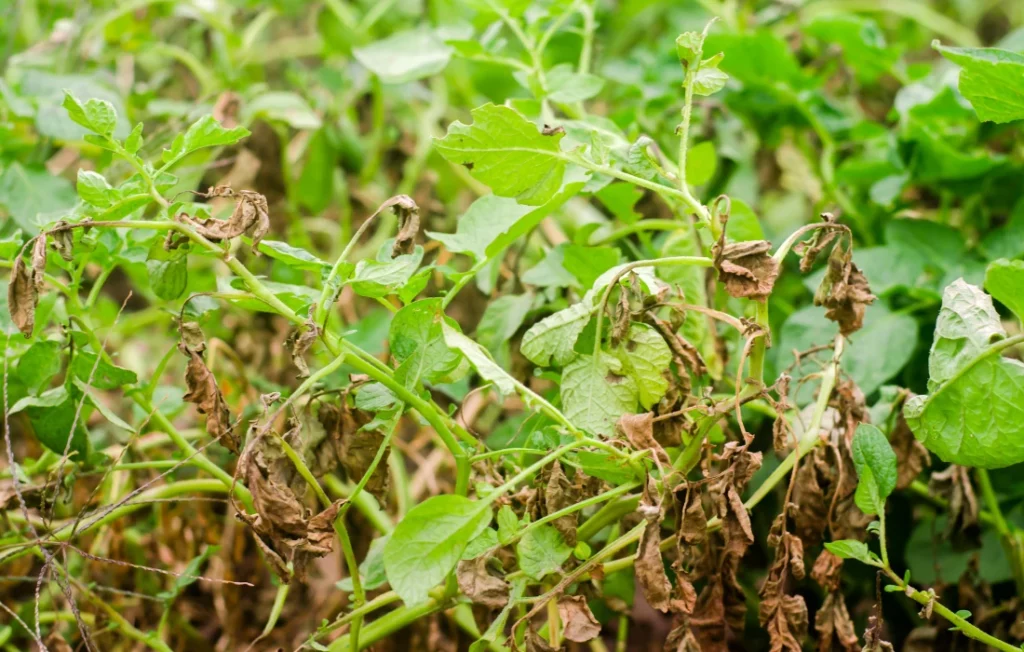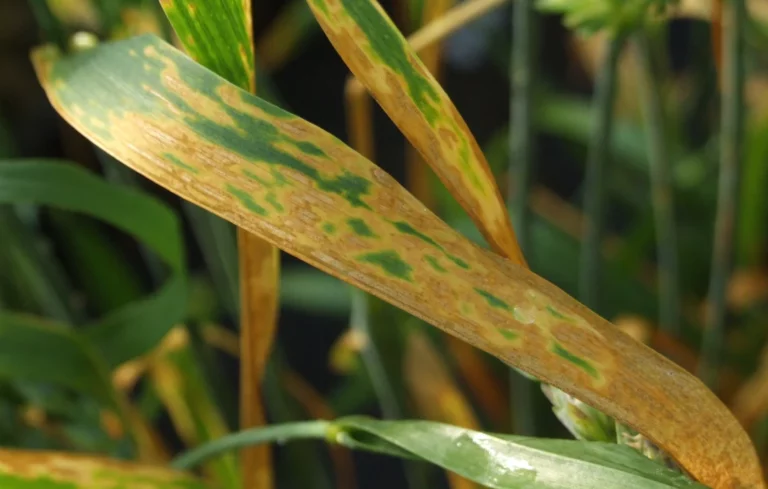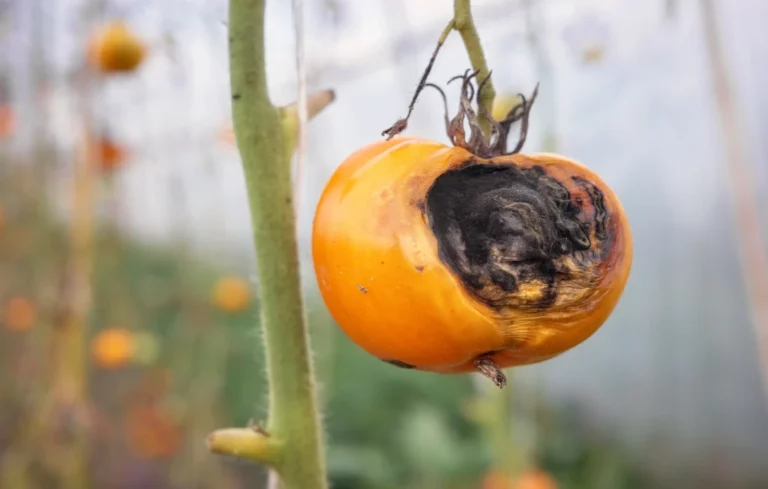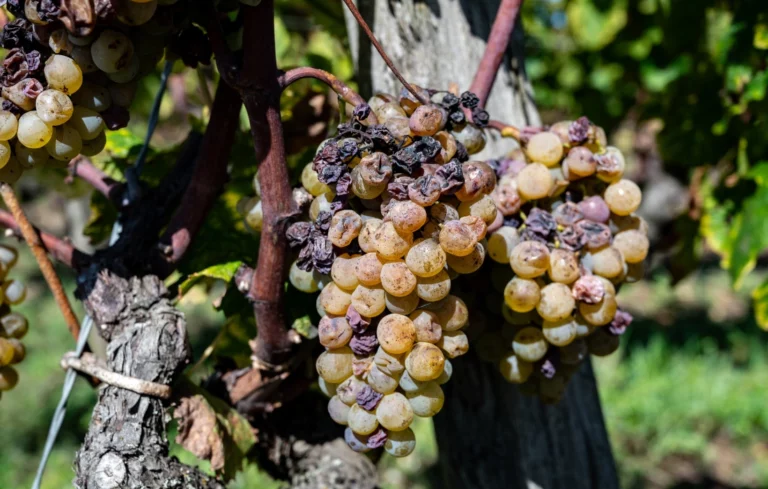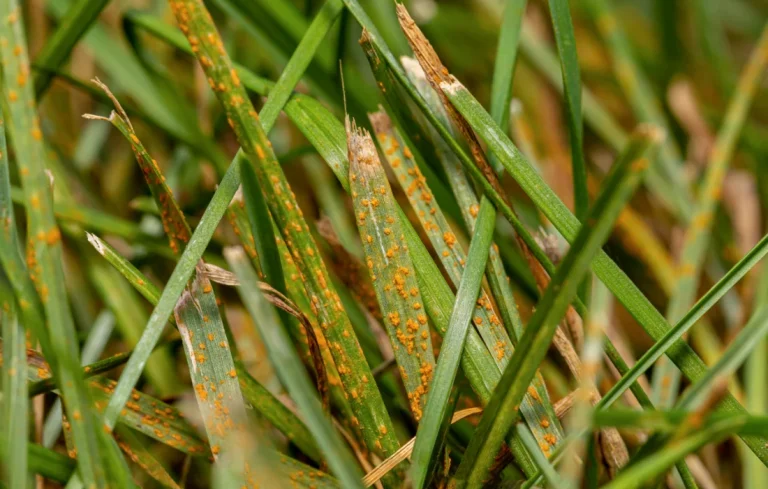Potato blight is one of those diseases feared by all growers. Once it takes hold, it leaves plants with little chance. Dark spots on leaves, drooping stems, and rotting tubers are just the visible symptoms of an often devastating attack. At Agrobiotop, we create natural control treatments to contain this threat.
What causes potato blight?
Potato blight, caused by Phytophthora infestans , is a particularly virulent fungal disease . It is not limited to potatoes, as it also affects tomatoes (Tomato powedery mildew), another widely cultivated nightshade. Phytophthora is an oomycete, an organism more closely related to algae than to true fungi.
In temperate climates, the disease takes hold as soon as humidity rises. The spores need free water on the leaves to germinate, then penetrate the tissues through the stomata. Once inside, progression is rapid, especially on susceptible varieties. Without intervention, yield losses can exceed 70%, ruining months of work in a matter of days. Downy mildew can completely decimate a crop, causing not only economic losses but also contamination of stocks.
History and impact
Downy mildew was first identified in the United States in 1843, before crossing the Atlantic and causing an unprecedented humanitarian catastrophe: the Irish Potato Famine of 1845–1851 . Introduced to Europe via contaminated tubers, it first affected France in 1844, then Belgium and other parts of Western Europe. At that time, farmers, without suitable control measures, saw their crops disappear, and with them, their only source of livelihood.
Since then, late blight monitoring has been ongoing, particularly to detect the emergence of more aggressive or treatment-resistant strains. History has shown that this disease can have a considerable impact on food crops, and this remains true today, particularly in regions where potatoes are a staple crop.
Need a natural solution for potato blight?
Conditions favorable to the development of potato blight
Potato blight develops when temperatures range between 16 and 22°C, with peak activity following a rainy period. The presence of free water on the leaves is essential for spore germination. When nights are cool and days are moderately warm, moisture remains suspended longer, promoting infections. Conversely, prolonged heat above 25°C slows the development of the pest.
This climate, typical of spring and early summer, must therefore be closely monitored. Damp areas of the field, poorly maintained edges, and depressions where water stagnates are all entry points for the disease. It is in these hotbeds that the first attacks are often observed.
Life cycle of Phytophthora infestans
Phytophthora infestans survives in crop residues and tubers left in the soil or stored in piles. It overwinters as mycelium or oospores, ready to emerge again as soon as favorable conditions return. In spring, sporangia form and release motile zoospores, which swim in the water to reach the stomata of host plants.
Contamination can also come from spontaneous regrowth or contaminated plants reintroduced into the field. Once established, the disease spreads very quickly, carried by wind and rain over long distances. From one plant to another, from one plot to another, it advances relentlessly. Intervention that is too late leaves room for rapid spread, with irreversible consequences for the yield and quality of the tubers.
Symptoms of potato blight
Downy mildew manifests itself in characteristic ways on different parts of the plant. Here are the main signs to look out for:
- On the leaves : the first thing you notice is the appearance of brown, oily spots , often on the edges or in the most humid areas of the plant. In humid conditions, a whitish felting may develop on the underside, corresponding to the spores of the pathogen. These lesions spread quickly, causing the foliage to dry out completely .
- On the stems : brown spots appear, usually at the nodes. They weaken the structure of the plant and contribute to its collapse.
- On tubers : the damage is particularly damaging. Purplish to brown lesions are observed on the skin, which indicate an internal infection. When the tuber is cut, rust- colored flesh is revealed , which is in the process of decomposing. These potatoes become unfit for consumption or sale. Worse still, they are vectors of secondary contamination , favoring the development of opportunistic bacteria or fungi. In storage, the disease can spread and ruin the conservation of the entire harvest.
AGROBIOTOP SOLUTIONS
Damp areas of the field, poorly maintained edges, and depressions where water stagnates are all entry points for the disease. It is in these hotbeds that the first attacks are often observed.
At Agrobiotop, we have developed natural solutions that can combat potato blight:
- SILIBOOST : It aerates, oxygenates, and loosens soils. It helps soil microorganisms work better and faster for better yields.
To effectively combat
Effectively fight mildew using the synergy of the solutions below
- CHITOPROTECT (chitosan, Elicitor)
- BENTOBIO (Very strong drying power when sprayed or powdered, this solution dries up stagnant water on the leaves following rain or high humidity, essential for mildew to infest the crop)
- YAKAPRO (rich in orthosilicic acid, it strengthens the walls of plants thus preventing the penetration of inoculum).
Prevention of potato blight
Here are the most effective cultural practices to prevent its development:
- Extend crop rotation : Avoid growing nightshades (potatoes, tomatoes) on the same plot for several years in a row. A 3- to 4-year rotation helps break the pathogen cycle.
- Spacing the plants : Good spacing between plants promotes air circulation, reduces stagnant humidity and reduces the duration of leaf wetness, conditions essential for spore germination.
- Weed regularly : Weeds create a humid microclimate that is favorable to the development of mildew. Frequent weeding helps limit this excessive humidity.
- Manage crop residues : After harvest, remove regrowth, tops, and contaminated plant debris. These residues can harbor the pathogen and cause infections the following year.
- Choose less susceptible varieties : Some varieties have partial tolerance to downy mildew. They are not disease-free, but their resistance helps slow the progression of the disease and save valuable time in the event of high pressure.
Other potato diseases:
Photo : Shutterstock

